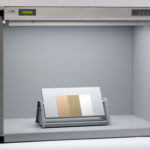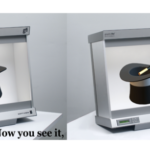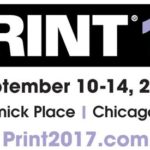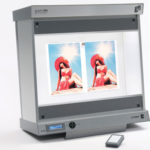March 1, 2011
Controlled lighting will save your life.
SURPRISE!!!
That’s the sound of the colors on your next project unexpectedly scaring the bejeezus out of you (or worse, out of your clients!)
Rather not be scared to death? Controlled lighting will save your life. Ok so it all depends on whether you consider accurate color to be your life, but controlled lighting WILL save your color.
If you make decisions about color, get comfortable for the next five to ten minutes because this article is for you. Don’t think you have five to ten minutes to spare right now? Better read faster! Unless you’d rather spare some time later… Saaay however long it takes you to redo your next color project/product from scratch… And better factor in some extra time for arguing with disappointed clients… Oh, and add some time for re-strategizing a different way to correct the highly specific appearance or replication of your product too… This is how much time you’ll have no choice but to sacrifice if you don’t use controlled lighting for your color management. So…got five minutes?
You may have heard the hype about standardized color viewing lighting and wondered what it was all about. If you’re NOT using controlled lighting to make critical color decisions, you’re just as good as working in the dark. The only viable reason for NOT using controlled color viewing lighting is that you don’t particularly care about color in your product’s performance. If you don’t care about color…well, you do care or you wouldn’t have read this far – so this is hype you’d better believe! (Unless you like surprises.)
See the light of day: Graphic Arts & Photography

You may have chosen thus far to ignore standard lighting systems, especially if you’re already using state of the art software and equipment to manage color, so you’re pretty sure that color viewing lighting isn’t that important to your work right? Wrong. You use your sophisticated equipment to make critical color decisions, and controlled color viewing lighting is equally as important. The reason you pay attention to the equipment you use to create your product is so that you can control as many variables as possible that could affect your product’s outcome. Lighting is no exception. It’s another factor – and frankly a very influential one – that affects the final rendition of your colors. You wouldn’t try to make decisions about color without the equipment or software you’re already using, and you shouldn’t do it without color viewing lighting either. Here’s why it’s time for you to start (literally) seeing the light of day.

Standardized color viewing lighting systems for graphic arts and photography are designed to simulate daylight. Depending on your industry, different temperatures of natural daylight are considered standard. Regardless of your industry, standards of lighting have been set to improve the quality of color rendering to enable professionals (or amateurs) of any kind to get a better idea of how their product will appear, and to make communicative decisions about color. For example, the newest international color viewing lighting standard for photography and graphic arts is the ISO 3664:2009. Of course, in order to gain these color viewing benefits of the standards that have been set for your industry, you need to use controlled lighting that meets these standards.
Now you may be thinking, “Well I don’t need to use special color viewing lights because my product isn’t going to be seen in that specific an environment.” Or maybe you’re thinking that you can just take your product outside to examine it. Don’t be blinded by these incorrect common assumptions. Any changing factors in your lighting would diminish your ability to exactly replicate colors, or to communicate them with others. Controlled color viewing lighting is essential for consistency, efficiency, accuracy, and communication when it comes to color management.
What if it’s rainy and gray outside during the time you’re trying to assess your product? Or what if you are trying to get the colors on your products in New York the same as those in Miami, do you think the daylight conditions in both places would be the same all the time? Not all daylight is created equal. This scale shows the visual effects of the correlated color temperatures of various sources of light. Think about how differently you see color in each of these situations. Now think about whether you’d want to roll the dice on creating your product under just any light. The results could be devastating! You need the benefits of standardized lighting systems to be able to see more clearly any discrepancies between your original artwork and its replications.
See it in a different light: Textiles
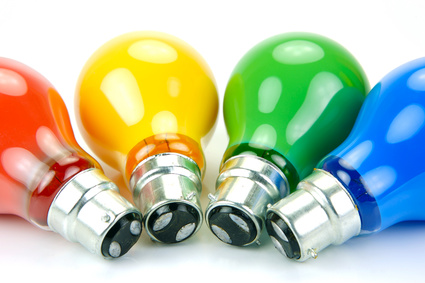
Don’t underestimate the significance of quality lighting in designing your product’s appearance. Simply put, without light, there is no color. Yes, having sophisticated equipment and software is essential to creating your product, whatever it may be, but how can you truly know what the product looks like without standardized lighting? How can you be sure that each time it is replicated it will appear the same as the original? Or that it will come out looking exactly as your client requested? The answer is you can’t. Having controlled lighting allows you to make important decisions about your product’s final appearance. It also allows you to communicate these decisions with people in other locations by viewing colors under the same types of controlled lighting, and therefore makes equal replicas of your product possible and simple. Even measured colors are based on the assumption of a [controlled] reference light source. The bottom line is that when lighting changes, colors appear differently. Hence, the need to control lighting.
You need the benefits of standardized lighting systems to be able to see how your product will appear outside of just the viewing environment it is created in. There are options for standardized lighting that include UV, fluorescent, and incandescent lighting selections, allowing the user to view the product under a variety of lighting environments before making decisions. Take a look at the room below during three different phases of daylight. Wouldn’t you like to be able to predict that your paint (or plastic or fabric) would have this type of color shift before it hits shelves?

Having control over your lighting conditions helps to identify potential color disasters like metamerism in certain lighting environments or the problematic effects of optical brightening agents. And when you are evaluating color output in digital color management, viewing environment is particularly essential. But controlled lighting goes beyond just the type of light source, accounting for a variety of viewing factors that affect color perception, factors that most people never even consider could be consequential. Standardized color viewing light systems ensure color consistency by controlling for light intensity and evenness, and viewing angles, which your regular overheard room lighting simply cannot do. Even factors like the surrounding color of your viewing environment affect perception of an object’s colors. GTI color viewing systems will even remind you when it’s time to replace your lamps to ensure the continued quality of your light source!
Wouldn’t you want to be able to see and anticipate any color shifts before your customers or critics do? It’s simple math that the more variables you control in ANY situation, the less unpredictable the outcome will be. Enter controlled color viewing lighting systems.
Below is a GTI Graphic Technology Inc multi-source color matching viewing system showing how some objects appear in several different types of lighting.

Even with the best color management equipment and software, without standardized lighting, you’re still just guessing at how your colors will appear. To truly have control over managing your colors, you need to have controlled lighting. But don’t take our word for it! Here are some real life examples of people who learned they had to look into the light…the hard way.
- A well-known department store company tried to save money by using cheaper 5000K lamps in their color viewing systems, resulting in much confusion and frustration between locations in product production.
- A print management company stood to lose a multi-million dollar client account because their lighting was not standardized and led to their client’s approved designs coming out completely wrong.
- A popular clothing store did not use controlled lighting during their manufacturing process, resulting in products arriving in unexpected colors, causing very costly mistakes.
- A leading celebrity and human-interest magazine used different types of lighting side by side, leading to serious print color discrepancies.
Now aren’t you glad you spared those few minutes? These examples are just a small few of the number of people who didn’t understand just how important controlled lighting is, and paid for it in more ways than one. We’re so happy we don’t have to add you to this list! Now that you know how important controlled lighting is for color viewing, we know you won’t try to go without it. Whatever your color viewing needs are, GTI has your solution, and the only surprises you’ll get with our products are good ones. Now get back to work! And consider your life saved.

